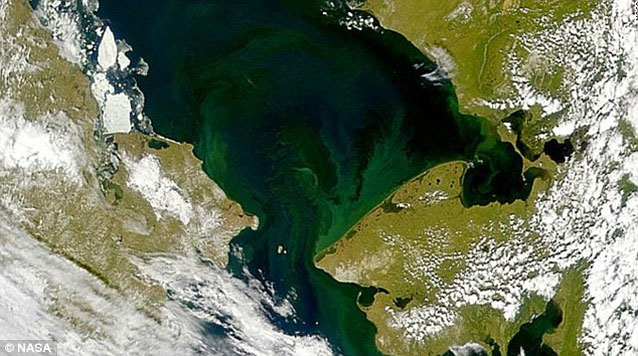Detects shock under the Arctic ice shelf
This finding was compared to NASA's finding the Amazon rainforest in the heart of the Mojave desert.
DailyMail page reported, scientists have found an extremely interesting and incredible phenomenon in the Arctic, when a giant aquatic algae carpet, up to 100km long is jubilantly flourishing underneath the water surface deep.
"This is the largest sub-ice aquatic algae ever found, as long as the 1,000 pitches around the football field ," NASA said. Previously, scientists thought that thick ice shelves would prevent marine plants from receiving the sunlight needed to grow and multiply. Therefore, when they witnessed the scene of giant algae blooms, they were really 'shocked'.

This giant algae is 100km long
Aquatic algae and phytoplankton are the basic link in the ocean food chain, and have a great impact on the Earth's atmosphere in general. Tiny algae cells will absorb up to 45 billion tons of carbon dioxide each year and supply up to half of the oxygen to the planet.
According to DailyMail, scientists are conducting NASA ICESCAPE expedition in Chukchi waters in the middle of Alaska with Japan, accidentally "clashed" with algae mats. After drilling through a meter of ice more than a meter thick, they found that the density of aquatic algae here was four times higher than in the area where the sea water did not freeze around.
'If anyone ever asked me about seaweed blooming under ice this way, I would tell them it's impossible , ' said the team leader Kevin Arrigo, a researcher from Stanford University.
Instead of stopping light, Arrigo believed that the melting ice actually functions as a magnifying glass, concentrating the underwater sunlight towards the algae carpet and providing a perfect environmental condition to carry out. Aquatic plankton can proliferate.
Moreover, the ice also helps protect the algae carpet from ultraviolet rays. As a result, they grow twice as fast as open water areas.
- Melt ice will liberate hundreds of millions of tons of methane gas
- For the first time in the world Russia explored the Arctic seabed
- Marvel at the space below the Antarctic ice shelf at a depth of 300 meters
- Shelf life of new style
- Two ice cracks threaten the Antarctic research station
- Shock detection in ice cores in the Arctic - the most remote waters
- Interesting facts about animals living in the Arctic
- Tips for dealing with
- Students invent a small shelf, earning $ 2 million a year
- Thermal shock: Danger of life when riding in a sunny car
- Arctic sea ice area is at a record low
- Every second 14,000 tons of water flows into the sea because the Arctic ice melts
 Is the magnetic North Pole shift dangerous to humanity?
Is the magnetic North Pole shift dangerous to humanity? Washington legalizes the recycling of human bodies into fertilizer
Washington legalizes the recycling of human bodies into fertilizer Lightning stone - the mysterious guest
Lightning stone - the mysterious guest Stunned by the mysterious sunset, strange appearance
Stunned by the mysterious sunset, strange appearance